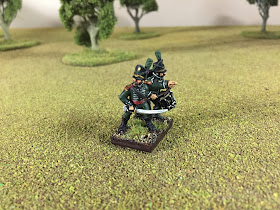There are however two potential inaccuracies in that the lacing on the cuffs was pointed, as opposed to square as was the case with the Cacadore regiments, and it is doubtful that they wore the barretina - being raised and equipped in England they were almost certainly initially outfitted with the stovepipe. However, I can vaguely recall I read somewhere that they were depicted at some stage in Portugal in the barretina, although I can't now recall where I read this or if it might just have been wishful thinking on my part:
As many might know the Legion was initially under the command of Sir Robert Wilson, who comes across as an independent adventurer, albeit a man of some capacity and who, it could be imagined, would relish having the three arms in a small mobile force which could strike and then move quickly. It is also not hard to imagine that this would not sit too well with Wellington, and Wilson departed fairly soon after the former's arrival to seek adventure elsewhere.
The Legion would ultimately be absorbed into the regular Portuguese army in the form of the 7th, 8th and 9th Cacadores, although it is interesting to note that the first battalion of the Legion was with Beresford defending the town and bridge at Albuera while the 8th Cacadores were with Wellington at Fuentes de Onoro, which does imply that even as late as mid-1811 the LLL continued to operate concurrently with the units into which they were to be eventually amalgamated.
There is a lot more to the LLL than that, and one book I have on the reading list for 2017 is Lillie and Mayne's book to flesh things out more.
All things considered it was just nice to paint something in green again and, above all, to have finished the Portuguese army. I'll try to get them all out for a group photo before moving on to the next project. I'm still struggling with that one, and know I need to paint some French, but the call of the Calpe Prussians and Saxons is increasingly hard to resist.
That's one for the New Year though, and I hope everyone who reads this has a happy and successful 2017!

















































